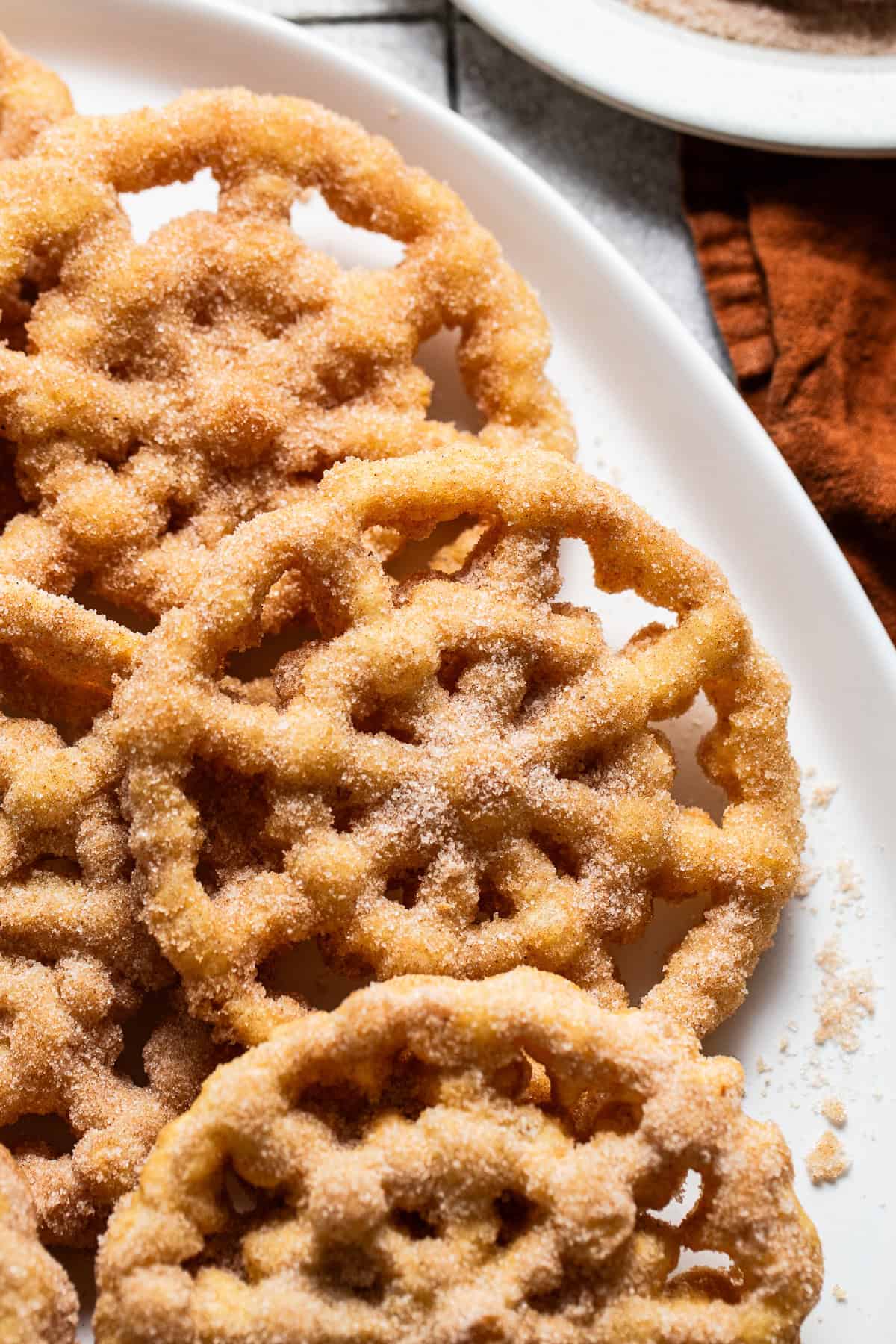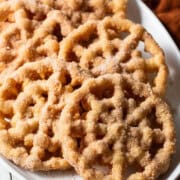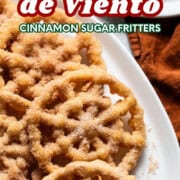Buñuelos de Viento are a traditional Mexican fritter tossed in cinnamon sugar made with a special rosette-shaped iron mold. These light and crispy treats are popular during Christmas time but use everyday ingredients for the dough that can be enjoyed any time of year!

On Christmas and New Year’s Eve, my family goes all out and makes a variety of traditional Mexican foods like tamales, pozole, and ponche. Some years, we also make a big stack of buñuelos.
My sisters grew up in Mexico, so they often talked about how they enjoyed buñuelos de viento, which are slightly different from the buñuelos I grew up eating and that my family still prepares.
Buñuelos de viento are made with a special iron mold that’s shaped like a rosette or star. They’re light, crispy, and so so good!
Here’s why I love this recipe:
- Made with simple ingredients: The batter for these buñuelos is made with simple pantry staple ingredients like all-purpose flour, sugar, salt, milk, and vanilla extract.
- Fun to make: It may take a couple of tries to get the technique down, but half the fun of buñuelos is making them! They also look super impressive. 😉

What Are Buñuelos de Viento?
Buñuelos de viento, or wind buñuelos, are a popular Mexican dessert and snack traditionally served during Christmas time. These light and crispy fritters are fried until golden brown and then dipped in cinnamon sugar.
What makes them special are the techniques and tools used to fry them. A decorative iron rosette mold is heated in frying oil, dipped in the batter, and then lightly fried. The result is a thin and crispy rosette-shaped treat that is usually paired with champurrado, atole, or café de olla.
Buñuelos de viento vary by country and region. Some recipes use a choux pastry that is rolled into balls and fried, resembling churros or donut holes. In Mexico, buñuelos de viento are typically made in a thin, crispy rosette shape.
Ingredient Notes

- All-purpose flour: This pantry staple is used to make the dough. The buñuelos are light and crispy, so you only need 1 ¼ cup to make about 25, depending on the size of your mold.
- Sugar: Granulated sugar sweetens the batter. You can also use turbinado sugar or a sugar substitute of your choice.
- Fine salt: I prefer to use fine salt for baking and desserts since it mixes a bit more evenly than a coarser salt does.
- Eggs: Adds some creaminess and binds the batter together.
- Milk: I used whole milk for the creamiest batter, but you could also use 2% milk or even a milk substitute.
- Vanilla extract: Adds an extra layer of flavor.
- Oil: Use any neutral oil like canola or vegetable oil for frying so it doesn’t affect the flavor of the buñuelos.
- Cinnamon sugar: Buñuelos de viento are coated in a simple cinnamon sugar mixture. Add a dash of nutmeg for an extra warm and holiday flavor.
How to Make Buñuelos de Viento

Make the batter by mixing together all-purpose flour, sugar, and salt in a medium bowl. In a separate bowl, whisk together the eggs, milk, and vanilla. Then combine the wet and dry ingredients.

Heat the mold. Fully submerge the rosette iron mold into the hot oil for 10-15 seconds. Lift it out, give it a little shake to remove any excess oil, and pat the bottom of it on a paper towel to remove any drips.

Dip the hot iron mold into the batter. Make sure to only dip ¾ of the mold. Don’t submerge it completely. You will hear some sizzling.

Dip the coated iron mold into the frying oil and hold it there for a few seconds. Give it a little shake, and the batter should lift off. If the batter is not lifting, use the tines of a fork to help pry it off.

Flip and continue frying for about 1-2 minutes until golden brown, then transfer it to a baking sheet lined with paper towels to absorb any excess oil. While the buñuelos are still warm, dip them in the cinnamon sugar mixture to coat both sides.
Recipe Tips
- This recipe is all about the technique. It may take a couple of tries to get the hang of it, so don’t get discouraged!
- Do not fully submerge the iron mold into the batter. If you do, it will completely coat the mold and not release when frying. Only dip the mold into the batter ¾ of the way.
- Keep the oil hot. The key to preventing the batter from sticking to the mold and not releasing is making sure the oil is at the correct temperature, and the iron mold is hot enough. Make sure to let the iron mold heat in the oil for at least 10-15 seconds before frying each buñuelo.
- Shake it off. To release the batter from the mold, you need to gently shake the mold while submerged in the oil to allow it to loosen and release as it fries. If you’re having trouble removing the batter from the mold, use the tines of a fork to help pry it off.
- Try different shapes. Buñuelos de viento are traditionally a rosette shape, but you can also use other shapes and sizes like stars or flowers. Keep in mind that the larger and more intricate the mold, the more difficult it may be to remove it when frying. In these cases, use the tines of a fork or a small heat-safe utensil to pry off the buñuelo.
- Add some citrus flavor. You can add 1-2 tablespoons of orange zest for a sweet and citrusy flavor.
- Prep ahead of time. This batter can be made up to 2 days ahead.
Serving Suggestions
Buñuelos de viento are traditionally served during Christmas and New Year’s with other holiday drinks like Mexican hot chocolate, rompope, atole de elote, or atole de galletas María.
You can also dip it in cajeta or dulce de leche for an extra sweet treat!
Things You Will Needs
- Rosette Iron Mold for Buñuelos. This iron mold set comes with several interchangeable shapes and 2 handles. It’s easy to assemble and is angled for even easier use.
- Instant Read Thermometer. Get the temperature of the frying oil right every time by using this instant-read thermometer. I use one nearly every day for baking and cooking.
Storage
To keep buñuelos de viento fresh, store them in an airtight container or a ziplock bag at room temperature for up to 3 days. Make sure they are completely cooled before sealing them to avoid any moisture buildup, which can make them soggy.
For the best results, I don’t recommend storing them in the fridge, as this can make them stale and affect their delicate texture.
More Mexican Recipes
If you tried this Buñuelos de Viento Recipe or any other recipe on Isabel Eats, don’t forget to rate the recipe and let me know how it went in the comments below! I love hearing about your experience making it!

Buñuelos de Viento
Buñuelos de Viento are a traditional Mexican fritter tossed in cinnamon sugar. These light and crispy treats are popular during Christmas!
Ingredients
For the buñuelos de viento
For cinnamon sugar topping
Instructions
-
In a large sauté pan or deep skillet, pour in 2 inches of frying oil and heat over medium heat until it reaches 365-400°F.
-
Prepare the cinnamon sugar mixture by mixing together the sugar and cinnamon in a small bowl. Set aside.
-
As the oil heats, make the buñuelo batter. In a medium bowl, mix together the flour, sugar, and salt.
-
In a separate medium bowl, whisk together the eggs, whole milk, and vanilla extract until fully combined and bubbly.
-
Mix in the dry ingredients into the egg mixture, ½ a cup at a time, until fully combined. The mixture should resemble pancake batter. Set aside.
-
Fully submerge the rosette iron mold into the hot oil for 10-15 seconds. Lift the iron mold, gently shake off any excess oil, and pat the bottom of it on a paper towel to remove any drips.
-
Dip the hot iron mold into the batter, coating only ¾ of the mold. You will hear some sizzling.
-
Dip the coated iron mold into the frying oil and hold it there for a few seconds. Give it a little shake, and the batter should lift off. If the batter is not lifting, use the tines of a fork to help pry it off.
-
Flip the buñuelo immediately and fry for an additional 1-2 minutes until golden brown. Transfer to a baking sheet lined with paper towels to absorb any excess oil.
-
While the buñuelos are still warm, dip in the cinnamon sugar mixture until both sides are coated.
-
Continue heating the iron mold, coating, and frying the buñuelos until all the batter is used. I recommend frying 1-2 at a time since you have to work quickly.
-
Serve immediately with champurrado, atole, or cafe de olla.
Notes
- This recipe is all about the technique. It may take a couple of tries to get the hang of it, so don’t get discouraged!
- Do not fully submerge the iron mold into the batter. If you do, it will completely coat the mold and not release when frying. Only dip the mold into the batter ¾ of the way.
- Keep the oil hot. The key to preventing the batter from sticking to the mold and not releasing is making sure the oil is at the correct temperature, and the iron mold is hot enough. Make sure to let the iron mold heat in the oil for at least 10-15 seconds before frying each buñuelo.
- Shake it off. To release the batter from the mold, you need to gently shake the mold while submerged in the oil to allow it to loosen and release as it fries. If you’re having trouble removing the batter from the mold, use the tines of a fork to help pry it off.
- Try different shapes. Buñuelos de viento are traditionally a rosette shape, but you can also use other shapes and sizes like stars or flowers. Keep in mind that the larger and more intricate the mold, the more difficult it may be to remove it when frying. In these cases, use the tines of a fork or a small heat-safe utensil to pry off the buñuelo.
- Prep ahead of time. This batter can be made up to 2 days ahead.
Nutrition Information
Serving: 1buñuelo, Calories: 67kcal (3%), Carbohydrates: 14g (5%), Protein: 1g (2%), Fat: 1g (2%), Saturated Fat: 0.3g (2%), Polyunsaturated Fat: 0.1g, Monounsaturated Fat: 0.2g, Trans Fat: 0.001g, Cholesterol: 14mg (5%), Sodium: 21mg (1%), Potassium: 27mg (1%), Fiber: 0.2g (1%), Sugar: 9g (10%), Vitamin A: 35IU (1%), Vitamin C: 0.003mg, Calcium: 16mg (2%), Iron: 0.4mg (2%)
Photography by Ashley McLaughlin.





